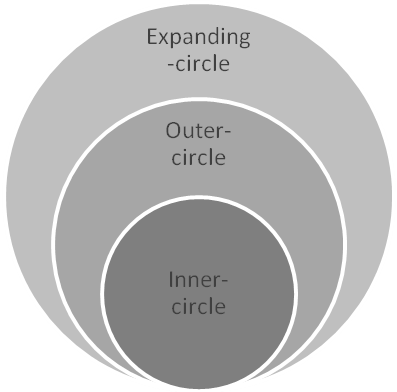
Eugenia Netto - English, II-LM - a.a. 2008-2009
In green are the explicit connectives (other than “but”, “and”, “so”, etc.). The more green you see, the easier the paper is to follow and understand
TASK 2
CORRECT THIS STUDENT'S ANSWER TO A QUESTION ON AN IMAGINARY EXAM
Exam Question: Which Englishes have "norm providing" status?
A Student's Answer: Most people consider the English language to be a single thing but in reality it is many things, many Englishes. This is because there is no single variety that is both rooted in a geopolitical community and used as a universal standard. Thus, "English" is a fiction; only "Englishes" exist. Of all the Englishes born in Britain and in her former colonies, some have conserved Anglo cultural values and, in their respective communities, constitute the prestige models: General American, Cultivated Australian, R.P. English, etc. They are what Kachru calls the "norm providers". Others, especially those that use English words to express local cultural values (Indian, Singaporean, Philippine, Nigerian Englishes for example), have traditionally taken their linguistic norms from the first group, although lately they have started to become "norm developing" and many people already call them "New Englishes".
[The above information “situates” your answer below. This is an example of being explicit Anglo-style. (Obviously, for an Italian, it is superfluous to give the information above since the teacher surely knows it. ) So congratulations on successfully changing mentality.]
What should the student have written to accommodate better to her teacher's Anglo mentality?
My answer:
The Englishes which have ‘norm providing’ status are: R.P. English (UK), General American (USA) and Cultivated Australian (Australia).
These varieties of English are identified by Braj Kachru (Kashmir, 1932) [very clever but for a journalistic article, not for an academic paper. In a news article we want to know where Kachru is from and how old he is. But in an academic paper, Kachru as a person disappears; only his books and scientific papers count.] , an expert linguist in the field of world Englishes1. Kachru (1985) proposed a Concentric Circles Model composed by of three main categories in which the English varieties of English can be divided. The following graph illustrates this model:

<People’s Republic of China, Japan, Korea, Italy, Holland, Brazil…
< India, Nigeria, Singapore, Jamaica, the Philippines…
^UK, USA, Australia
The three circles are an idea a model based on the status and functions of Englishes. First of all, the Inner-circle includes the varieties in the countries country where the English language has its origin (the UK) and those countries where it is the dominant language as a result of a first emigration (the UK, the USA, Australia, New Zealand etc.). These Inner-circle Englishes are considered as ‘norm providing’ varieties. [Why are they considered “norm providing”? Since you are making an effort to be clear, you should explain the meaning of this technical term: “...because they are imitated by other countries.”]
Then, Next, the Outer-circle counts in contains the varieties developed in the countries where English came was introduced through colonization and has an official status, such as in India, Nigeria, Singapore, the Philippines and others places. The Outer-circle Englishes are defined as ‘norm developing’ varieties.
Finally, the Expanding-circle comprises the varieties that are developing [NO! In these countries the variety of English used is NOT developing; these countries simply take SBE or GA as their model, they don't try to change it or develop it.] in countries where English is used primarily for international purposes as in People’s Republic of China, Japan, Korea, Italy, Holland, Brazil etc. The Expanding-circle Englishes are termed ‘norm accepting’ or ‘norm depending dependant’.
Moreover, on one hand, the Inner-circle Englishes provide norms and then also as well as teaching models and physical materials to the Expanding-circle: in Korea, for example, US English is considered the prestige model, in Italy the R.P. English and so on. On the other hand, the situation of the Outer-circle is more complicated because there are countries where English is banished, others which adopt one or another Inner-circle model and still others which adopt a regional or local model. This situation concerns many countries in South Asia and Southeast Asia.
Indeed Kachru’s Concentric
Circles Model is only a kind of classification of the different
varieties of English. Tom McArthur (1992),
for example,
defines New Englishes the ‘recently
emerging and increasingly autonomous variet[ies] of English,
especially in a non-western setting, such as India, Nigeria, or
Singapore’ which are countries where
English is an official, but not necessarily the first language. The
term is used to contrast with the so-called Anglo Englishes or Older
Englishes, that means the varieties of English spoken in the United
Kingdom, the United States, Canada, New Zealand and Australia.
However, the term New Englishes
is sometimes
also used more broadly to refer to all varieties of English except
for those spoken on the British Isles.
[The
part in red is COPIED from
http://en.wikipedia.org/wiki/New_Englishes.
This is something you should NEVER do in an Anglo learning situation,
such as this English class. It is considered plagiarism and is
severely punished. You can use the ideas contained in Wikipedia but
expressed with YOUR words. Or you can use the words of Wikipedia but
giving credit to the source by putting the words in quotation marks
and citing the source.]
Anyway [This word, used as a connective, is too informal for an academic paper] these distinctions don’t take into account the status and functions of Englishes and then so they are not useful to in defineing which varieties are models as ‘norm providers’ for the others.
Links for this task:
http://en.wikipedia.org/wiki/Englishes
http://en.wikipedia.org/wiki/English_language
A nice attempt at being explicit Anglo-style but lacking in accuracy and (declared) documentation.
1The phrase ‘world Englishes’ is used to refer to the English language in global context (B. Kachru, 1982, 1986, 1992; Smith 1981, 1983, 1987; Strevens 1980) because English language doesn’t exist as a whole single entity all around the world.